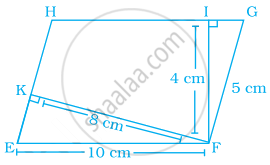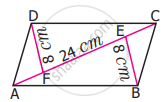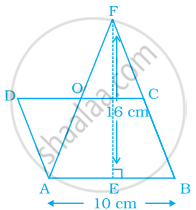Advertisements
Advertisements
प्रश्न
In the given figure, EFGH is a parallelogram, altitudes FK and FI are 8 cm and 4 cm respectively. If EF = 10 cm, then area of EFGH is ______.

विकल्प
20 cm2
32 cm2
40 cm2
80 cm2
उत्तर
In the given figure, EFGH is a parallelogram, altitudes FK and FI are 8 cm and 4 cm respectively. If EF = 10 cm, then area of EFGH is `bb(underline(40 cm^2))`.
Explanation:

From the figure,
Consider the parallelogram EFGH,
EF = HG = 10 cm ......[From the question]
We know that, area of parallelogram EFGH = Base × Corresponding height
= 10 × 4
= 40 cm2
APPEARS IN
संबंधित प्रश्न
Area of a parallelogram is 83.2 sq cm. If its height is 6.4 cm, find the length of its base.
A parallelogram has sides of 20 cm and 30 cm. If the distance between its shorter sides is 15 cm; find the distance between the longer sides.
Find the missing values.
| Base | Height | Area |
| 17 mm | 221 sq.mm |
The area of parallelogram whose base 10 m and height 7 m is
What happens to the area of the parallelogram if the base is increased 2 times and the height is halved?
Find the area of the parallelogram ABCD if AC is 24 cm and BE = DF = 8 cm
Find the height of the parallelogram whose base is four times the height and whose area is 576 sq.cm
If the sides of a parallelogram are increased to twice its original lengths, how much will the perimeter of the new parallelogram?
In the given figure, area of ∆AFB is equal to the area of parallelogram ABCD. If altitude EF is 16 cm long, find the altitude of the parallelogram to the base AB of length 10 cm. What is the area of ∆DAO, where O is the midpoint of DC?

In the given figure, find the area of parallelogram ABCD, if the area of shaded triangle is 9 cm2.

